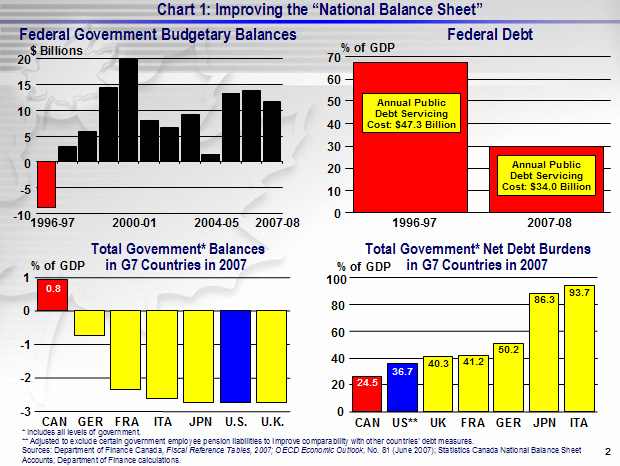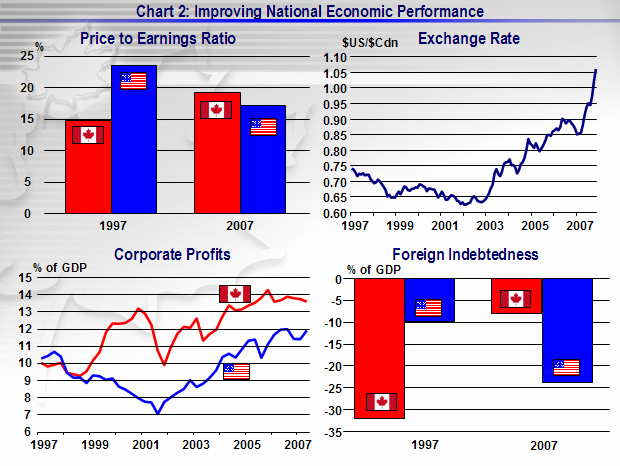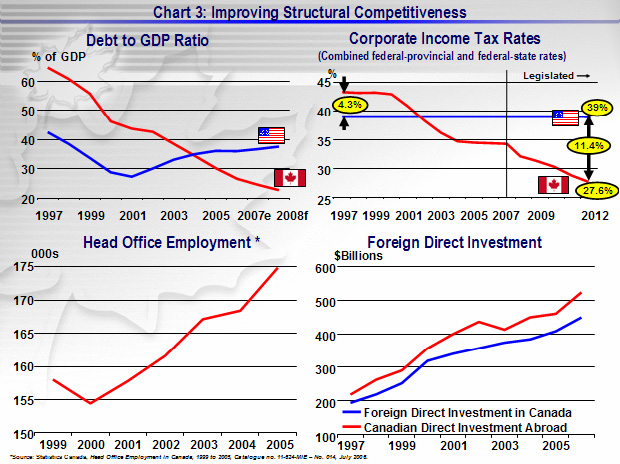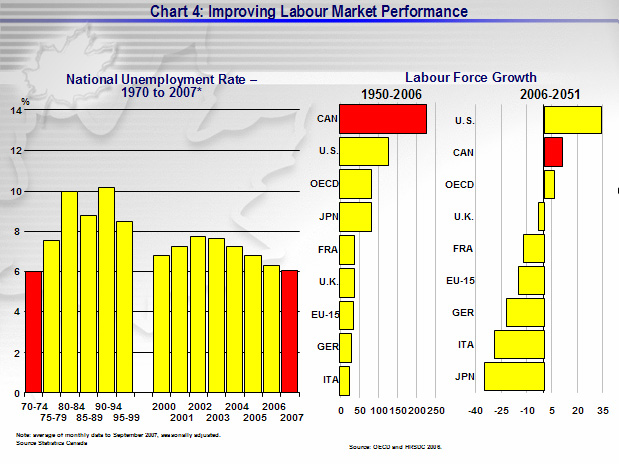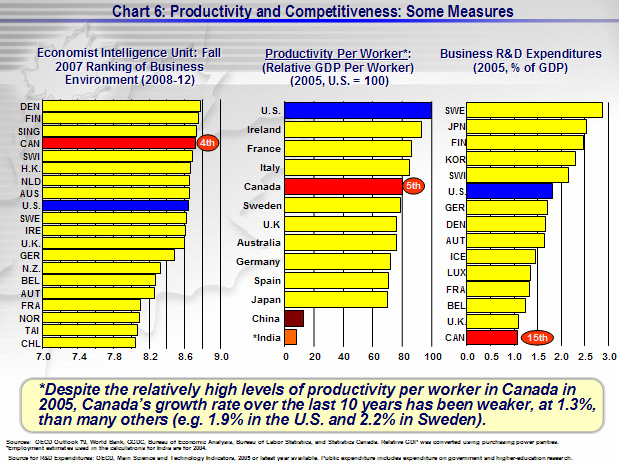Common menu bar links
Succeeding in a Globalized World: Canada's Challenge and Opportunity
Remarks by the Clerk of the Privy Council
And Secretary to the Cabinet
November 15, 2007
The Richard Ivey
School Of Business, University Of Western Ontario
London, Ontario
Introduction
It is an honor to have been asked to present this year’s Leaders Lecture at the Richard Ivey School of Business, and I thank you all for the opportunity. The Ivey Business School, and its Lawrence Centre for Policy and Management, are to be commended for their objective of being at the “cutting edge of thinking about the nexus between public policy and business strategy”. It is very much in that context that I would like to focus my remarks. Specifically, on what it will take for Canada, and Canadians, to succeed in the profoundly globalized world of which we are an integral part, whether we always like it or not.
At the outset, it’s worth remembering the wise words of Yogi Berra, who once observed: “It’s tough to make predictions, especially about the future”. Equally, in addressing a topic so potentially vast, I am mindful of the even wiser words of Albert Einstein that: “Everything should be made as simple as possible, but no simpler”. Most importantly, if you are searching for wisdom in these words, as a business school you would appreciate the adage that “you only get what you pay for”, and this is a free lecture.
In today’s global economy, the constant opportunity is ever bigger markets, and the constant challenge is ever more competitors. As Tom Friedman has so perceptively observed: “If globalization were a sport, it would be the 100 meter dash---over and over and over.” In this world, how do economies best position themselves to meet the challenges and reap the opportunities provided by globalization, and to increase their standards of living? Why do some countries, big and small, move ahead of the pack while others, often with similar endowments, fall back? What does it take to “stay ahead of the global curve”?
The best place to start is by reviewing the implications of today’s pervasive globalization. It now seems almost trite to say that globalization has fundamentally changed how all of us do our business --- whether that be government, the private sector or university researchers --- but it still bears repeating, and understanding. There are five dimensions of globalization that I want to address today.
First, global capital markets now truly operate 24/7, linking savers and investors around the world. And, in a world now marked by large current account imbalances, the magnitude of the flows can be staggering. Returns are arbitraged not just across sectors and regions, but across continents in a relentless “search for yield”. Global markets provide great depth, reducing the cost of credit, but if information about new financial instruments is not sufficiently transparent, the result can be a mis-pricing of global financial risk.
As well, perturbations in one country or sector may now be felt both near and far. In 1990s we came to understand this when shocks hit non-reserve currencies such as the Russian rouble, the Mexican peso and the Thai baht with global consequences. Recently, we have seen the global impacts of troubles in the U.S. sub-prime mortgage market. National financial authorities increasingly have to think globally as they act domestically.
Second, the business counterpart to global capital market integration is global supply chains. What started off as “outsourcing” in the 1980s and grew into “off-shoring” in the 1990s has now become strategic “global supply chains”. Each stage of corporate value-added can be located anywhere in the world, and increasingly is so. The great surge of exports to North America reflects the growth in global supply chains linked to countries throughout the world, reducing business costs for North American firms and keeping consumer prices lower. At the same time, however, it has led to concerns about product quality and safety and, like global financial instruments, if information is not transparent, there can be a mis-pricing of product risk.
Third, the globalization of information is perhaps the most dramatic of all. Driven by the ICT revolution of the 1990s, global information markets have morphed radically. In less than a generation we have gone from the “wonder” of 24/7 global images delivered by CNN, to instantaneous global data collection and dissemination systems such as Bloomberg, to globally interconnected information networks enabled by the internet, to easily accessible knowledge through extraordinarily sophisticated search engines such as Google, to digital global social interaction networks such as YouTube and Facebook. This ongoing information revolution is enabling pervasive globalization --- today’s integrated global capital markets and global supply chains couldn’t exist without it. At the same time, this profound density of personal, corporate and social information, housed in ubiquitous networks and unknown servers around the world, raises real questions of information protection, privacy and security.
Fourth, environmental concerns are rapidly globalizing, and the global nature of climate change is clearer, better understood and more urgent. Neither the atmosphere that protects us nor the ecosystems that nurture us are segmented by national boundaries. With the world production of greenhouse gases (GHGs) up almost 25 per cent over the last 15 years, and the largest emitter of GHGs now a developing country, China, not a developed one, climate change is clearly a global issue that all countries need to deal with, both nationally and multilaterally.
And fifth, there has been the globalization of insecurity. The same means that have enabled the benefits of globalization can also be exploited for much less positive aims. Organized crime and drug cartels have exploited globalization for their pernicious ends. The internet provides global reach for marketing fraud, exploitation of individuals and cyber-crime. Global epidemics are a risk; as Canada experienced earlier in this decade, diseases from anywhere can become a threat to us. Most worryingly, 9/11 demonstrated that terrorism is now a global problem not a national or regional one.
Preparing for Globalization: The Basics
The key question for us is what does all this mean for Canadian businesses, and for Canadian public policy? First, we need to remember that globalization is not a new phenomenon; what is new is its pervasiveness and intensity. As C.D. Howe observed in the early 1950s: “Canada’s future depends to an important degree upon the retention of a flexible, adaptable economy. While there is every reason to believe the best is yet to come, progress will not be automatic. The world is not being run to suit the Canadians.”
Perceptive then, essential today. Howe, along with others such as Lester Pearson and Bob Bryce, understood better than most of their generation the challenges and opportunities of the nascent globalization.
They also understood the need for international institutions to help establish the rules-of-the game, and Canada played key roles in the establishment of institutions such as the International Monetary Fund, the World Bank, the agencies of the United Nations, NATO, the General Agreement on Tariffs and Trade (GATT) and the Organization for Economic Cooperation and Development. This international architecture is largely unchanged today despite the dramatic events of the last 60 years.
Fast forward to the early-1990s. Internationally, with the breaching of both the Berlin Wall and the Great Wall, eminent historians were quick to declare the “end of history”, the victory of market-based systems and an enduring peace dividend. But the reality today is that history is proving its durability, state-capitalism is not the same as market capitalism, and peace, while given a chance, remains frustratingly elusive. With the various international financial crises of the 1990s, questions about whether the international architecture was up to the task in a world of pervasive globalization began percolating.
Canada was not exempt from such challenges in the 1990s. A wake up call was the Wall Street Journal editorial of January, 1995 entitled: “Bankrupt Canada?” which asserted that “Mexico isn’t the only U.S. neighbor flirting with the financial abyss. Turn around and check out Canada, which has now become an honorary member of the Third World”. At the same time, public commentators in Canada were worrying about a hollowing out of Canada, citing a low dollar, depressed stock market, low profits, high interest rates and high government debt. All told, not a pretty picture of Canada was being painted.
But the Canadian resiliency that C.D. Howe referenced re-asserted itself. Strong action turned fiscal deficits into surpluses, improving business competitiveness turned current account deficits into surpluses, and surpluses allowed tax cuts which propelled profits (Chart 1).
Nirvana, hardly; progress, surely.
Responding to Globalization: The Challenge of Today
These improving trends have continued through 2007. Today, the exchange rate has rebounded from under 70 cents to parity and above. Price-earnings ratios are above U.S. levels and long term interest rates are lower. Canadian corporate profit rates are now higher than in the U.S. while corporate statutory tax rates are now much lower than U.S. levels. Canada has shifted from the second most indebted country of the G7 to the least indebted. And, our net foreign indebtedness is now approaching balance while the U.S. is rapidly approaching Canadian levels of the mid-1990s (Chart 2).
What about corporate Canada? While nominal national income (GDP) is up 75 percent since 1997, the level of corporate profits has soared almost 140 per cent. By market value, the top 25 firms on the TSE/TSX are worth 275 percent more today than in 1997, with the overall index up a robust 170 percent. The Canadian economy has long been a recipient of foreign investment which has provided leading edge technology, new products and processes, and access to global markets. Over the last ten years, Canadian firms invested more abroad than foreign firms invested in Canada for the first time, making Canada a cumulative net exporter of foreign direct investment (FDI) to the tune of $67 billion. And, amid all this churn of companies buying and being bought, expanding and contracting and investing, Statistics Canada reports that the number of head offices and employment in head offices in Canada has increased since 2000 (Chart 3).
Despite these positive developments, challenges remain. For example, echoes of a decade earlier, there are voices in the business community worrying about a hollowing out of corporate Canada, whether Canada is losing key headquarters functions and, more generally, whether Canadian firms are sustaining their global competitive edge. These are important issues, and require a solid factual and analytic basis for public policy discussion. To provide this context and to help frame the policy issues, the Government of Canada has appointed a panel of eminent Canadians (The Competition Policy Review Panel), chaired by Mr. L.R. Wilson, to review Canada’s competitive and investment policies to ensure they are working effectively in today’s global market place.
What about Canadian labour markets? They, too, are affected by globalization. Highly skilled workers --- researchers, investment bankers, IT specialists, or oil workers--- now increasingly inhabit global labour markets rather than regional or national ones. There is greatly increased competition among countries for skilled immigrants. And, many countries around the globe, including China, will soon face demographic labour market challenges, with declining proportions of their populations of working age, thereby accentuating these global labour pressures (Chart 4).
Canada is going through a fundamental change in its labour markets. After decades of excess supply of labour, we have recently shifted into a period of excess demand for available labour, a period which may prove quite durable. The unemployment rate today is at a 35 year low, and growth in employment going forward is more likely to be constrained by supply than by demand. In part driven by demographics, in part by the changing structure of the Canadian economy, in part by global demand for natural resources, this may prove to be a turning point with consequences for all of us ---business persons, educators, workers, students and public policy makers. Slower growth in labour supply, and a shift to a more knowledge-intensive economy, will demand a more educated and better skilled workforce. Canadian business, workers and educators need to be at the leading edge of this shift (Chart 5).
What about Canadian innovation? Innovation lies at the heart of global competitiveness. Whether you prefer the OECD definition of innovation as “ new products, business processes and organic changes that create wealth or social welfare” or that of Joseph Schumpeter that : “ without innovation, no entrepreneurs, without entrepreneurial achievement, no capitalist returns and no capitalist propulsion”, the message is the same. Being successful in the endless quest to develop new products, new business processes, new global markets --- will be key to Canada’s future global competitiveness, and Canadians’ future standards of living. A fairly well known innovator by the name of Henry Ford captured the essence of the transformative nature of innovation by commenting that “If I had asked my customers what they wanted, I would have built a faster horse.”
On the innovation front, Canada’s recent story is mixed (Chart 6). There has been a rapid expansion in public sector investment in research and development, as well as institutional innovations in how we deliver it such as the CFI and the Canada Research Chairs, but private sector investments in R&D lag our global competitors considerably. We will have to do better to compete globally, with more emphasis on excellence, greater strategic focus in where we concentrate our R&D efforts and more commercialization of our research. And, with Canadian business sector investment in R&D ranked 15th among OECD countries, expanded private sector involvement in innovation is key.
What about Canada’s global economic footprint? It is bigger than Canadians sometimes think, with a $1.5 trillion economy, the second highest standard of living in the G-8 (8th highest in the OECD), and large reserves of natural resources, including oil and gas, in an ever-growing global economy in need of them. We are also adjacent to, and integrated with, the world’s largest and most dynamic economy, but we need to be concerned that our borders are both secure and efficient to jointly grow our prosperity. And we are a trading nation, with trade responsible for 36 percent of GDP. But Canada, after being an early pace-setter in negotiating bilateral trade and investment arrangements, has fallen behind a number of our global competitors over the last 10 years. For example, Canada has ratified FTAs with only 5 countries compared to 20 for the U.S. and 47 for Mexico.
What about the Canadian public service? First and foremost, it matters. As the 2007 Report of the Prime Minister’s Advisory Committee on the Public Service bluntly stated: “.. a well-functioning and values-based public service is critical to the success of every country in today’s complex and interconnected world. As a national institution, a high quality merit-based Public Service is part of Canada’s comparative advantage and a key to competitiveness in the global economy. It also helps provide the foundation for sound democratic government.”
We are in the midst of significant public service renewal in Canada. Driven by demographics and the simple fact the last large-scale renewal was over 30 years ago, many public servants, particularly executives, can retire now or over the next several years. We need to attract Canada’s best and brightest to public service as part of this renewal. As part of this, Canadians need to understand the important role the public service has played, and needs to continue to play, in the ongoing success that is Canada.
Conclusion
Returning to the challenge posed at the outset, how to succeed in a globalized world, a country where business, labour and government share a unique and common perspective on globalization is Ireland. Their approach is strategic, focused and multi-tiered: they focus on what it will take them to get into the global game and win: cost competitiveness; good infrastructure; emphasis on innovation, entrepreneurship and management capacity; attractive tax regime; and world class education. An Irish Prime Minister once famously remarked about the Irish approach: “sure it works in practice, but does it work in theory.”
Interestingly, the Economist Intelligence Unit, after analyzing a similar range of factors that they argue constitute being globally competitive today, recently ranked Canada fourth in the world for the competitiveness of our business environment over the next five years.
Solid progress, surely; time for complacency, hardly.
In this context, let me conclude by offering several thoughts for global success:
That Canada --- business, government, universities, labour --- be strategic in our thinking, and focused in our approach. We can’t do everything, be everywhere, so let’s pick our spots and do what we do superbly.
That Canadians avoid too short term a perspective in their planning and corporate strategies. The time frame matters, and Canada is in this global competition for the long haul. As that great business strategist Yogi Berra once remarked: “If you don’t know where you are going, you won’t know when you’re lost”.
That Canada’s strength lies in its people, their respect for the rule of law and human rights, their willingness to innovate, their entrepreneurship and their values which define Canadians at home and abroad.
That Canada makes excellence it’s standard and goal. Simply being “average” just isn’t good enough with the quality of global competitors we face.
As C.D Howe observed a half century ago, Canadian success in the global economy is not preordained. However, given what we have achieved to date, our resources and our people, the global opportunities of tomorrow are there for us to seize.
Thank you.

